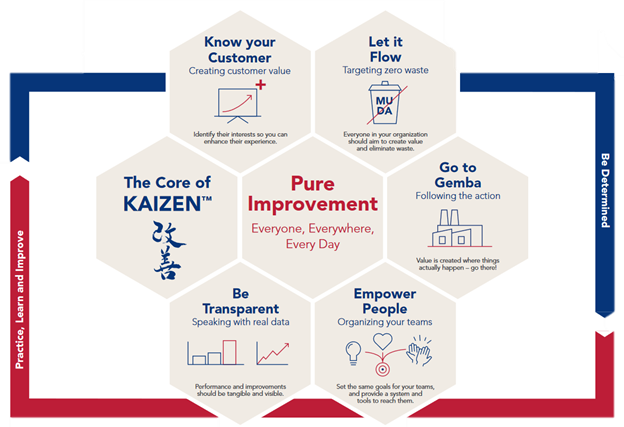Operational excellence and continuous improvement go hand-in-hand when aiming to achieve a lean organization. However, they are not the same thing. Continuous improvement can be defined as an ongoing effort to improve an organization’s processes, products, or services over time. While continuous improvement is essential, it is generally not enough. On the other hand, operational excellence is about applying the right tools and processes to create an ideal work culture that empowers employees to take ownership of the operational flow, thus ensuring that continuous improvement remains constant.
What is operational excellence?
Operational excellence refers to the process of executing a business strategy more reliably and consistently than the competition, resulting in increased revenue, lower operational risk, and lower operating costs. It is not about cutting resources but how to apply them better.
Even though it seems obvious, it is crucial to understand that operational excellence focuses on operations. Operations include not only the most transactional areas, such as production, logistics, procurement, maintenance, and quality but also all other business areas, from sales to research and development to finance.
Why is operational excellence important?
Operationally excellent companies manage their operations intending to deliver their product or service to the customer at the exact moment they desire it, at the lowest cost, with the slightest effort, and at a price the customer is willing to pay for.
This end-to-end process promotes employees’ interests and well-being, fosters a nurturing work culture, contributes to surpassing customer expectations, and increases the chances of overcoming the competition. All in all, operational excellence unlocks the secret to a business’s success.
Research from Harvard Business Review found that companies with top operational excellence have 25 percent higher growth and 75 percent higher productivity than laggards. Operational excellence yields tangible results in all components of an organization’s business, known as GQCDM: growth, quality, cost, delivery, and motivation. Below are some of the commonly perceived benefits of operational excellence.
Benefits of operational excellence
- Growing sales and customer satisfaction
- Efficiency in processes and use of resources
- Cost optimization
- Engaged, stable workforce
- Cohesive management
- Strong shareholder value
- High-quality standards
- Beneficial partnerships with suppliers
Operational excellence methodologies have powered performance gains at many well-known companies, including Toyota, Philips Lighting, General Electric, Nestle, Danaher Corporation, Johnson & Johnson, and Amazon.
Operational excellence methodologies
To achieve operational excellence, several methodologies can be employed, each offering unique tools and perspectives for continuous improvement:
- Kaizen: focuses on continuous, incremental improvements involving everyone from top management to front-line workers. It emphasizes employee involvement, regular team meetings, and a culture of constant, small changes that collectively lead to significant enhancements in efficiency and quality.
- Six Sigma: is a data-driven approach that seeks to eliminate defects and reduce process variability. By employing statistical methods and a structured problem-solving process (DMAIC: Define, Measure, Analyze, Improve, Control), Six Sigma aims to improve process quality and consistency.
- Lean Manufacturing: aims to maximize value by minimizing waste. It focuses on identifying and eliminating non-value-added activities, optimizing workflows, and enhancing productivity. Techniques such as Value Stream Mapping, 5S, and Just-In-Time production help streamline operations and deliver products efficiently.
What are the key Kaizen principles of operational excellence
There are five fundamental principles embedded in every operational excellence tool and behavior. The principles are: Create Customer Value, Let it Flow, Go to Gemba, Empower People and Be Transparent.

The implementation of these five principles in any organization is absolutely vital for a thriving culture of continuous improvement and organizational excellence.
Create customer value
Like the related theories of KAIZEN™ and Six Sigma and other operational excellence methodologies, the focus is on the concept of value. These theories define value from the customer’s viewpoint. Value, in essence, represents what the customer wants and is willing to pay for.
Companies should not focus on products or services to create value but identify customers’ interests and enhance their experience.
Organizations must also stop thinking that only the end customer matters. All operations within the organization are important, the “next operation” is always towards the customer.
Create flow efficiency
Flow. In a word, that is the driving force behind operational excellence – seeing the value of flow and understanding how to fix it when it is blocked.
“All we are doing is looking at the timeline, from the moment the customer gives us an order to the point when we collect the cash. And we are reducing the timeline by reducing the non-value-adding wastes.”
Taiichi Ohno, father of the Toyota Production System
To create flow efficiency, companies should look for flow breakers or waste. What is considered waste depends on the business characteristics and needs. However, a model was developed that defines the seven types of Muda, and it can be applied to all business areas.

After realizing where waste is, the following steps should be waste elimination and value expansion. In other words, companies should reduce waste and replace it with value-added activities.
Go to Gemba
To see what is happening in their company and why it is happening, managers should go to Gemba – the place where things actually happen. Decision-making should be based on facts and accurate data, not opinions or guesses.
It’s not easy to get a dynamic Gemba nor guarantee that it remains dynamic as time goes by. The process of going to Gemba should be standardized to ensure effectiveness and consistency.
“Management by walking around is hardly ever effective because someone in management, walking around, has little idea about what questions to ask, and usually does not pause long enough at any spot to get the right answer.”
W. Edwards Deming
Empower people
Instead of being the inspector, blaming everyone, which provokes a climate of crisis, the organization should use the principle of “no blame, no judge”. This principle is one of the simplest to understand and usually the most complicated to apply.
Therefore, organizations should work to develop leadership and empower people at all levels. This can be done through a teams’ development program where everyone is encouraged to participate in the improvement process having respect and appreciation as core principles.
At the same time, training and process confirmation play an essential role. They are fundamental pillars for sustaining results and developing people’s capabilities. When conducted with a coaching mindset, Gemba Walks guarantee that goals are understood and successfully translated to the work and stimulate people to think and decide for themselves while respecting the business. The deployment of new routines throughout the hierarchy creates an authentic cultural transformation movement.
Be transparent
Companies tend to show only positive results to motivate and increase the trust of their teams. However, it is also essential to display negative results to make people aware of the need for a change of course and attitude.
Visual management makes people accountable, promotes predictable and effective work, improves alignment, and helps achieve and sustain breakthrough results consistently. When information is transparent and easy to understand, it helps employees to do their job, and everyone wins.
How can I effectively implement lean management and achieve operational excellence
To implement lean management, companies may follow two approaches: continuous, incremental, and daily improvement in all the teams of an organization; and occasional, disruptive, planned, and focused improvement in certain areas with a specific and ambitious goal.
The lean management roadmap varies from business to business. However, organizational excellence builds on three building blocks: strategy development,leadership, process excellence, team management, and culture.

1. Strat KAIZEN™
Find the vital few strategic initiatives to transform the business, create a competitive advantage, and execute them exceptionally
2. KAIZEN™ Events:
Improve business processes by following cycles of KAIZEN™ Events with project teams in order to deliver breakthrough results.
3. Daily KAIZEN™:
Instill KAIZEN™ behavior in all teams to develop a culture of continuous improvement and incrementally improve performance.
Companies pursuing operational excellence should adopt a mindset of problem-solving, teamwork, and top-line growth. Shifting to a Continuous Improvement culture means that behaviors must change and time to do KAIZEN™ must be found.
Do you still have some questions about operational excellence?
What is continuous improvement?
Continuous improvement, sometimes called continual improvement, is the ongoing improvement of products, services, or processes through incremental and breakthrough improvements.
The term continuous improvement can be very abstract if not placed in a specific context. It refers to a never-ending strive for perfection in everything you do. In Lean management, continuous improvement is also known as KAIZEN™.
What is the KAIZEN™ methodology?
KAIZEN™ is a proven approach to creating continuous improvement every day in all areas of an organization, and with the involvement of everyone – leadership, management, and employees – based on the identification and elimination of Muda (Japanese term for waste).
Through the book ‘KAIZEN™: The Key to Japan’s Competitive Success,’ Masaaki Imai – founder of Kaizen Institute – introduced the term KAIZEN™ in the western world in 1986. Today, KAIZEN™ is recognized worldwide as an essential pillar of an organization’s long-term competitive strategy.
Lean KAIZEN™ aims to overcome managerial and operational paradigms – a model, rule, or habit that influences how a given situation or problem is dealt with within an organization.
What is Lean Manufacturing?
Lean Manufacturing is a systematic approach focused on maximizing value by eliminating waste in production processes. It aims to streamline workflows and enhance productivity by identifying and removing non-value-added activities. Key techniques include Value Stream Mapping, 5S, and Just-In-Time production, all of which help ensure efficient operations and deliver high-quality products quickly and cost-effectively. Lean Manufacturing encourages a culture of continuous improvement, engaging employees at all levels to contribute to process optimization.
What is Six Sigma?
Six Sigma is a set of methods and tools for business process improvement and quality management. Six Sigma aims to improve quality by finding defects, determining their cause, and improving processes to increase the repeatability and accuracy of process results.
The term Six Sigma originates from the statistical modeling of manufacturing processes. The maturity of a manufacturing process can be described by a sigma rating that indicates the yield of the process or the percentage of defect-free products it creates – in other words, within how many standard deviations of a normal distribution is the fraction of defect-free output. In fact, Six Sigma is a data-driven problem-solving methodology.
See more on Operations
Find out more about improving this business area
See more on Quality
Find out more about improving this business area
